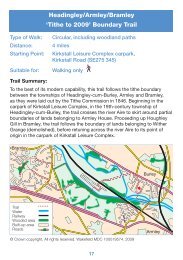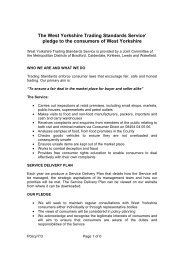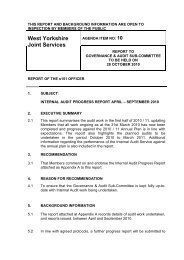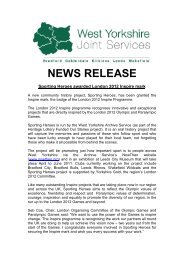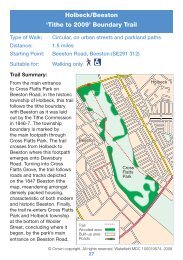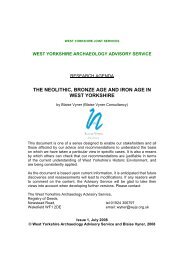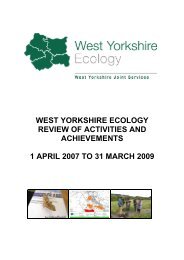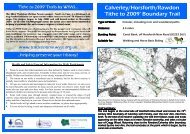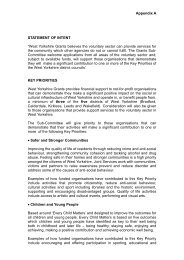(WYL1782/2/2) c1917 Photograph album including photographs of factory workersmaking First World War shells and various First World War shell factoriesContaining black and white photographs of George Mann and Company Stall at the National WelfareExhibition in Leeds Town Hall [1917] with factory workers demonstrating the making of First World Warshells, photographs of interiors of Larchfield Mill Shell Factory, Larchfield Works Shrapnel Shop, GoodmanStreet Shell Factory, Atkinson Street Brass Foundry, Chadwick Street Brass Foundry, Otley Works, Roll ofHonour listing George Mann and Company employees enlisted in the First World War.(WYL115/MA6) 1924 Plan of National Filling Factory, Barnbow, Dept. 85, LeedsThe declaration of war with Germany on 3 August 1914 created an urgent need for large volumes ofarms/ammunition although few establishments, apart from Woolwich Arsenal, were involved in this workespecially by mass production. Early initiative was taken by Leeds commerce and the city's major firms, withthe newly formed Leeds Munitions Committee quickly promoting production of shells at Leeds ForgeCompany, Armley. Works at Hunslet and Newlay (Horsforth) followed suit. A directing board comprising sixLeeds citizens, charged with the construction of the First National Shell Filling Factory, met in August 1915and a site was selected at Barnbow between Crossgates and Garforth, part of the Gascoigne estate.The main site, initially some 313 acres (later increased by extension to 400 acres), extended along theeastern part of Manston Lane, embracing two farms at Shippen and Lazencroft, with the North EasternRailway along the southern boundary. Possessions cleared away from the site were sold by auction, withconstruction plant and material being quickly transported from Leeds. The Ministry of Munitions architectswere Messrs Reed & MacDonald and the main building contractor Wm. Irwin & Co. of Leeds. Groups ofworkmen, employed by the NE Railway Company, constructed a railway siding laying a main trackway intothe factory complex. Platforms some 800 ft. long were built to the Barnbow Halt railway station with adjacentbooking office just south of the main factory entrance. The extensive cartridge factory buildings were quicklyassembled enabling filling operations to commence in December 1915, after three weeks preliminary trials.About 50 women were employed at this time, the work force eventually increasing to 16,000, 93% of thembeing women and girls. Rapid progress was made on building changing rooms, canteens, administrationblocks and many necessary support facilities. All workers were required to pass a medical examinationbefore employment (this was considered an added safeguard against claims imposing a burden on thecompensation department. Those employed in danger zones were periodically medically examined.Particular attention was given to personal welfare. A lady superintendent, with a staff of welfare workers, wasappointed to make regular visits to employees, either at work or during meal times. They also visited anyoneon the sick or accident list or those absent from work for any length of time. Tennis courts were available forrecreational purposes. A staff of qualified nurses, supervised by the resident doctor and augmented by VADworkers, manned the various rest rooms and surgery. Two qualified dentists manned the dental surgery andapparently, operating days became busy once 'word got around' that patients could expect caring and skilfultreatment. The fire brigade was one of the first units to be formed, originally with men but later girls weretrained. Eventually 30 girls and 6 firemen, under the control of a skilled firemaster from London, made up thecomplement. The main factory entrance was between Shippen House Farm and the railway station,incorporating a permit office, pay office and covered waiting room. An 'internal' guard, comprising units of theRoyal Defence Corps, of mainly time-expired ex-service men, maintained a 24 hour patrol of the securityfence and the superintendent of police with three inspectors controlled male police, whilst a lady
superintendent had charge of police women for female search purposes. All personnel were required to wearidentity discs and to carry permits, searches being regularly undertaken. Danger areas were under constantsurveyance, with 'safe' areas reserved for smokers. There was a complete press blackout of the area.Explosions occurred on three occasions, the first and most serious in one of the fusing rooms on the night of5 December 1916, when 35 women lost their lives. The injured were taken to the Leeds General Infirmary,aid being provided by the factory medical staff, the ambulance corps and the voluntary motor transportsection. Residents of Lazencroft Cottage, at the time, are understood to have witnessed crowds of workers,many with yellowed faces, rushing along Manston Lane, all in a state of great distress. The second accident,three months later on 21 March, 1917, killed two girls and in the third accident on 31 March, 1918 (a timewhen the King and Queen were visiting Leeds), three men lost their lives. In the traumatic aftermath of theseincidents, girls were found readily volunteering to resume work in the danger areas, once repairs had beenundertaken. Due to censorship, no account of the accidents was made public; however Field Marshall SirDouglas Haigh in a special order of the day issued from the British HQ in France, paid tribute to the devotionand sacrifice of the munitions workers. At the end of hostilities on 11 November 1918, all work stopped forthe first time. The grand totals of munitions production were :-B L Cartridges of all sizes completed 36,150,000Shells filled 24,750,000Shells completed with fuses and packed 19,250,000Tonnage of finished ammunition despatched overseas 566,000(further information can be found at: http://barwickinelmethistoricalsociety.com/4746.html, accessed14/08/13)Anti-War/Conscientious Objectors(LMT/PU/P1236) February 1916–January 1918 Local tribunal war service appealscopy letter bookFrom 1916, men seeking exemption from military service could apply to various tribunals. There were threetypes: Local Tribunals, Appeal Tribunals and a Central Tribunal based in London. Local Tribunals wereappointed by the Local Registration Authorities designated under the National Registration Act 1915(effectively local burgh and city councils). They dealt with attested (voluntary servicemen) and non-attested(conscripted) applications. Recruiting officers or other military representatives were also entitled to attendany hearing and to question applicants. Appeal Tribunals were appointed by the Crown, and in Scotlandthese were located within sheriffdoms. Any applicant refused exemption by the Local Tribunal, or dissatisfiedwith the type of exemption granted, had a right of appeal to it. Conversely military representatives orrecruiting officers could appeal against the exemption granted to an applicant. A Central Tribunal wasappointed for the whole of Great Britain. Any person dissatisfied with a decision of an Appeal Tribunal couldappeal to it, but only provided they were given leave to do so. The Central Tribunal frequently took overcases in which conscientious objection was made by men who had already been called up. These recordssurvive in The National Archives at Kew. Exemptions granted by tribunals could be permanent, conditional or



